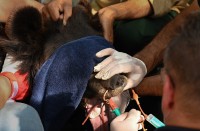JUNE 19 (Reuters) — Autonomy for robots is the Holy Grail for scientists seeking to expand their use in complex natural environments. As scientists develop robots for use in search and rescue, disaster response situations, health care and even exploration of other planets or deep oceans, improving the ability to adapt creatively and quickly is fast becoming an important factor.
A team of French researchers say they have moved a step closer with ‘spider’ robots that adapt their behavior in adverse conditions.
The team wanted to replicate the ability of animals to respond intuitively to unexpected obstacles or injuries. They came up with an intelligent “trial and error” algorithm that allowed their robot to adapt to damage within two minutes without human control.
Team member Antoine Cully demonstrated the robot and its learning algorithm in the lab.
“Disconnecting this cable will actually unfold all the leg, with three motors of the leg, and so the leg will be still present but not be able to rely on it or to move it. And so we will see now how it affects the behavior of the robot when he is damaged,” Cully explained.
The six-legged android walked across the floor in a straight line. Cully deactivated one leg and the robot appears to understand the problem. It tested two solutions before rectifying the situation.
The researchers said this is a simulation of childhood for the robot and will allow the use of robots beyond the factory floor.
“There are many other applications beyond the military ones. For example they can be used to help an elderly, to assist a disabled people for example but we can also imagine that it can be used to rescue people after a catastrophic situation,” Cully told Reuters.
Currently, robots do not usually adapt so quickly to obstacles or injuries. The learning algorithms commonly used by robotics scientists are often restricted to simple parameters or require human demonstrations. A robot that responds more like animals, within minutes of damage and without expensive self-diagnosing sensors is more practical and effective, Cully and his team said. A camera allows the robot to diagnose its problems much more quickly.







